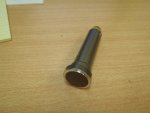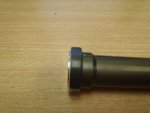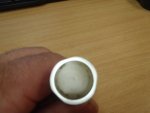I have a new Grendel and was cleaning it when I found this... It looks like the buffer retainer plunger is hitting the buffer, what can I do to solve this? if I back out the buffer tube it will make the stock loose. I have a Magpul PRS stock with Standard length tube, spring and buffer.
Join the Hide community
Get access to live stream, lessons, the post exchange, and chat with other snipers.
Register
Download Gravity Ballistics
Get help to accurately calculate and scope your sniper rifle using real shooting data.

Install the app
How to install the app on iOS
Follow along with the video below to see how to install our site as a web app on your home screen.
Note: This feature may not be available in some browsers.
You are using an out of date browser. It may not display this or other websites correctly.
You should upgrade or use an alternative browser.
You should upgrade or use an alternative browser.
Buffer damage, Help?
- Thread starter waveslayer
- Start date
It may not necessarily be the carrier that's out of spec. I have seen similar results on ARs where the lower was out of spec. Specifically, if the buffer detent pin hole in the lower was improperly placed too far rearward...toward the receiver extension/buffer tube...it can allow the buffer to make contact with the detent pin instead of the back of the carrier and cause exactly the buffer damage you are experiencing. The only time, on an in-spec, normally functioning AR, that the buffer should contact the buffer detent is when the upper is pivoted up or removed completely from the lower. All that pin does is "capture" the buffer and spring from popping out of the lower/launching.
What kind of lower receiver (make/model/etc.)?
What kind of lower receiver (make/model/etc.)?
The lower is one from Ares Armory that I milled out... sounds like the detent pin is too far back... bummer
Since that buffer is already boogered up I might would cut a notch around it where it is hitting. It might work and is cheaper than a new lower.
Sent from my Galaxy S3 using Tapatalk 2.
Sent from my Galaxy S3 using Tapatalk 2.
Can I just run the weapon with no spring and pin for the buffer? Then just watch out for a flying buffer when I field strip it? I am going to take some pics shortly...
can you post a pic? The damage is consistent with the explanation by ORD.
here are some pics. there are no burs anywhere, it's as thought the buffer spring is causing the buffer to hit the retaining pin too hard... if that makes sense...
Attachments
Its always difficult to tell much in the way of where a problem might rest (especially the prob you are experiencing) just from pics. I stand by my original statement that its the detent hole milled/drilled too far rearward in the lower that it causing the problem.
As for your proposed "fix" of just removing the buffer detent and spring and running the rifle without those parts...the short answer is YES, that WILL work. However, as you observed, every time you pivot the upper on the lower or remove it completely, you'll need to be prepared to catch flying components!
Milling the face of the buffer as also suggest may work depending on how much you have to remove to resolve the problem, but in turn, you weaken the buffer face somewhat which could result in other problems. You could also look into one of the "anti-cant" style buffers made for piston driven ARs that look like this: Heavy Buffers | Products
Those buffer were designed to deal with the issue of "carrier tilt" which won't be an issue in a DI rifle, but they do have the face of the buffer milled in a similar fashion to what you'd be doing to yours. The problem with doing that on a "standard" buffer is that there isn't nearly as much material on the face as Slash's anti-cant buffers and may cause the weakening of the buffer I mentioned above.
The best course of action is to replace or repair the lower, but I realize that gets expensive and poses other issues too.
Good luck!
As for your proposed "fix" of just removing the buffer detent and spring and running the rifle without those parts...the short answer is YES, that WILL work. However, as you observed, every time you pivot the upper on the lower or remove it completely, you'll need to be prepared to catch flying components!
Milling the face of the buffer as also suggest may work depending on how much you have to remove to resolve the problem, but in turn, you weaken the buffer face somewhat which could result in other problems. You could also look into one of the "anti-cant" style buffers made for piston driven ARs that look like this: Heavy Buffers | Products
Those buffer were designed to deal with the issue of "carrier tilt" which won't be an issue in a DI rifle, but they do have the face of the buffer milled in a similar fashion to what you'd be doing to yours. The problem with doing that on a "standard" buffer is that there isn't nearly as much material on the face as Slash's anti-cant buffers and may cause the weakening of the buffer I mentioned above.
The best course of action is to replace or repair the lower, but I realize that gets expensive and poses other issues too.
Good luck!
Run it without the buffer detent. Just open the rifle slowly. Happens a lot. A broken detent will F your day up. The broken detent will lock the rifle up at the worst time.
Can I just run the weapon with no spring and pin for the buffer? Then just watch out for a flying buffer when I field strip it? I am going to take some pics shortly...
This is your best option. Am I understanding you correctly in that you machined the pocket for the buffer retainer?
Another solution, albeit expensive, is a JP silent captured buffer & spring. No retaining pin needed as the weights and springs are held captive by the guide rod.
Another option would be to fill the buffer retainer hole, possibly with JB Weld or similar, and redrill it in the proper location. Or machine the front radius of the hole forward and back fill the area that shouldn't have been removed. Not really a high wear area,as the only time the retainer will move much is when the buffer is removed, maybe a bit of movement when the upper is removed and the buffer rests upon the retainer.
Another option would be to fill the buffer retainer hole, possibly with JB Weld or similar, and redrill it in the proper location. Or machine the front radius of the hole forward and back fill the area that shouldn't have been removed. Not really a high wear area,as the only time the retainer will move much is when the buffer is removed, maybe a bit of movement when the upper is removed and the buffer rests upon the retainer.
This is not only bad idea but it's a cunt hair past patently stupid.
I'd just run it without the detent and remember when it is time to field strip. Or, forget about it, and have some extra components on deck!
Appears to be the cheapest solution...Problems like this are pretty damn aggravating, but it could certainly be worse.
Appears to be the cheapest solution...Problems like this are pretty damn aggravating, but it could certainly be worse.
I CAN FIX THIS!!!!! Done it before. You will NOT have to make any expensive/tricky alterations etc. All you need is access to a lathe or take your buffer to a machinist. I just gotta figure out this picture attachment thing...... I'll get back with you soon I hope.
Here you go. Chuck the buffer in a lathe and make a cut on the buffer face 0.125" into the diameter and 0.030" into the length of the buffer. The pics explain it a lot better than I can. This will allow the buffer to protrude farther forward before it touches the retainer pin. When you hinge the upper closed, the bolt carrier will push the buffer back into the buffer tube slightly, as it is designed to do, preventing contact with the retainer during operation. Simple, cheap, effective. Your "out-of-spec" lower is now useable in a normal manner and all the nay-sayers be damned.






This is not only bad idea but it's a cunt hair past patently stupid.
Please elaborate as to why. I'm here to learn, if I know your reasoning I may be able to apply it elsewhere.
Another idea would be to remove the detent pin and replace the whole buffer assembly with a captured one.
Please elaborate as to why. I'm here to learn, if I know your reasoning I may be able to apply it elsewhere.
There is no place for JB Weld on your weapon, period, full stop. It's either made right or it isn't. Crazy statements such as the one you made only serve to marginalize your credibility. Just because it's your turn to talk doesn't mean you should.
I figure a machinist could suggest an appropriate substitute or technique to repair the improperly located portion of the hole, hence I said possibly JB Weld.
BTW, this is the internet, credibility is not applicable IMO
BTW, this is the internet, credibility is not applicable IMO
Last edited:
Here you go. Chuck the buffer in a lathe and make a cut on the buffer face 0.125" into the diameter and 0.030" into the length of the buffer. The pics explain it a lot better than I can. This will allow the buffer to protrude farther forward before it touches the retainer pin. When you hinge the upper closed, the bolt carrier will push the buffer back into the buffer tube slightly, as it is designed to do, preventing contact with the retainer during operation. Simple, cheap, effective. Your "out-of-spec" lower is now useable in a normal manner and all the nay-sayers be damned.
View attachment 16998View attachment 16999View attachment 17000
Seems like that would reduce the surface are in contact with the BCG, may or may not cause a wear issue, i.e. mushrooming or chipping of the contacting edge of the buffer. Though it may be better than running the gun without a retainer, that seems like it would increase the odds of losing/damaging parts or smashing fingers too much.
Last edited:
Mtrmn's idea would work. Another thing to look at, is your barrel extension flush with the inside of the upper receiver? If the extension sits in from flush, you can have the face of the upper cut down so that the extension sits flush, thereby moving the carrier back enough to contact the buffer when closed up.
I've only seen this once on one of my AR15 builds and that was my problem. Fixed by using an upper receiver facing tool and valve lapping compound.
I've only seen this once on one of my AR15 builds and that was my problem. Fixed by using an upper receiver facing tool and valve lapping compound.
Seems like that would reduce the surface are in contact with the BCG, may or may not cause a wear issue, i.e. mushrooming or chipping of the contacting edge of the buffer. Though it may be better than running the gun without a retainer, that seems like it would increase the odds of losing/damaging parts or smashing fingers too much.
I have 2 beater AR's at home that have been repaired this way. One is my truck gun that probably has a couple thousand rds through it with no noticeable wear. Whereas it only took about 50 rds before I noticed the face of the buffer getting beat up by the retainer. I would think running one for very long like this would elongate the retainer hole. When the gun is assembled, the bolt carrier is SUPPOSED to contact the buffer and push it backwards slightly-preventing contact between the buffer face and the retainer. The buffer and retainer should only meet when the upper is removed.
The buffer IMO is the sacrificial part here-much better to modify it than risk having to buy a new lower. And I was as surprised as anybody to learn that my idea actually worked as well as it does. I have not found a downside to this so far, and if I do buffers are cheap.
Shit, cutting that buffer would work, but unless you have access to the machinery, it may be cheaper or at least more cost effective to just get another lower.
Also, are you SURE it's the carrier or frame? It could be the headspacing --I'm guessing.
The Grendel was patented for a long time and folks made different chambers and bolt recesses in order to get around that. CSS sells a couple different bolt faces. I don't know what the consequences are for using slightly off bolts with the wrong chambers, but it would seem to me that may be a possible cause, albeit far fetched.
This would be mostly Grendel specific too, and I'd break out the calipers before I started replacing parts. That's just me.
Also, are you SURE it's the carrier or frame? It could be the headspacing --I'm guessing.
The Grendel was patented for a long time and folks made different chambers and bolt recesses in order to get around that. CSS sells a couple different bolt faces. I don't know what the consequences are for using slightly off bolts with the wrong chambers, but it would seem to me that may be a possible cause, albeit far fetched.
This would be mostly Grendel specific too, and I'd break out the calipers before I started replacing parts. That's just me.
None of Grendels I have owned ever had this problem. I don't think it is a Grendel specific problem. I think the problem is specific to YOUR firearm. So far, the cheapest fix is machining the face of the buffer. The best solution is getting a captive buffer and spring unit, but that is expensive. Of course, the best overall solution is getting a lower that is within specs so you don't have that problem, but there are other fixes that will work and be far cheaper. My order of preference for the suggested fixes:
1. Machine the buffer
2. get a captive buffer/spring unit
3. buy a new lower that is within spec
4. anything else
jb weld is somewhere down here...I don't recommend it though as stuff like that almost always comes undone at the worst possible time. Then you have gun parts, and chunks of JB weld down inside your lower with your fire control group. As you can imagine, extra gun parts and chunks of JB Weld around your fire control group will foul up your rifle's reliability.
1. Machine the buffer
2. get a captive buffer/spring unit
3. buy a new lower that is within spec
4. anything else
jb weld is somewhere down here...I don't recommend it though as stuff like that almost always comes undone at the worst possible time. Then you have gun parts, and chunks of JB weld down inside your lower with your fire control group. As you can imagine, extra gun parts and chunks of JB Weld around your fire control group will foul up your rifle's reliability.
Similar threads
- Replies
- 17
- Views
- 1K




